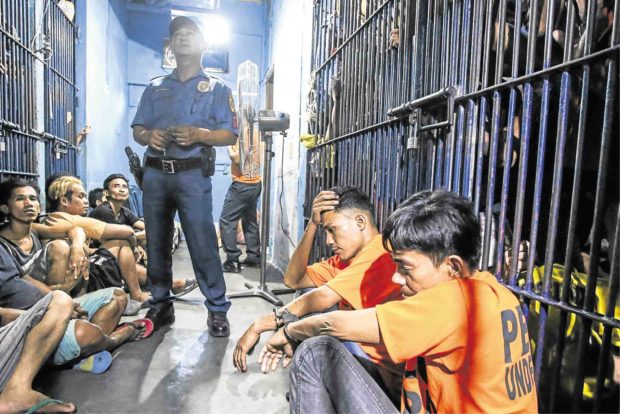Patay, 16 cops face raps for teen’s drug raid slay

NOTORIOUS A look inside Station 6, Batasan Police Station shows an overcrowded jail where drug suspects are packed. —JAM STA. ROSA
The Philippine National Police’s antiscalawag unit has found sufficient cause to file charges against 17 former Batasan policemen, including their commander, over the “gruesome and merciless” killing of a minor during a 2016 drug buy-bust operation in Payatas, Quezon City, the Inquirer learned.
The PNP Internal Affairs Service (IAS) report, which described the policemen as “corrupt” and “unworthy to remain in service,” starts summary dismissal proceedings against the policemen in what could be the first high profile alleged extrajudicial killing case since the start of President Duterte’s bloody campaign against drugs.
For “unlawfully and unjustifiably” killing 17-year-old Darwin Hamoy, the PNP’s IAS ordered the filing of grave misconduct and grave irregularity cases against SPO3 Carlo Abella; Marvin Merida, Rhodolf Makie and Ralph Pinero, all with the rank of SPO2; SPO1 Ronnie Banggat; Dennis Pal, Richard Timon, Edilberto Vargas and Nonilon Laberon, all with the rank of PO3; and Michael Maderable, Amirudin Ibrahim, Alberto Pombo, Andy Adlawan, Charles Molinos, Herbert Angoluan and Wilson Escuro, all with the rank of PO2.
Patay
The IAS resolution also charged Supt. Lito Patay, former head of Station 6 of the Batasan police, with grave neglect of duty for “failing to prevent” the abuses committed by his men and which led to Hamoy’s killing.
Article continues after this advertisementHamoy was killed with Cherwen Polo, William Bordeos, Sherwin Ternal and a certain “Rambo” in an Aug. 15, 2016, drug raid by the Station 6 policemen on the Polos’ house in the village of Payatas B.
Article continues after this advertisementIn September that year, their relatives—widows, Katrina Polo and Marlyn Bordeos, and mother Mariza Hamoy—challenged police claims before the PNP-IAS and the Office of the Ombudsman that the five victims had engaged police in a gunfight.
The women claimed that the five victims were at the Polos’ house to celebrate Cherwen’s birthday and that they were summarily executed by the team led by Pinero.
In a 10-page report approved on Oct. 17, the IAS said Hamoy’s “detailed narration of facts and circumstances, duly corroborated by Polo and Bordeos, is more convincing than the alibis of the policemen.”
Body in sack
This was a complete turnaround from a July 12 resolution from the Office of the Ombudsman, which ruled that the women’s testimonies “do not deserve credence,” since they were not present during the deadly police operation.
But the IAS ruled that there was sufficient evidence of treachery, which qualified the crime as murder.
It cited a forensic report on Hamoy, which found that he was shot in the lungs, as proof of the “gruesome and merciless killing.”
What the policemen did, the IAS resolution said, was “a clear transgression of established rules.”
It also held them accountable for placing Hamoy’s body in a sack and transporting it to Quezon City General Hospital, instead of letting forensics examiners process the crime scene.
“There is no doubt that they violated the norms of public service,” the IAS report said.
Command responsibility
The IAS also found Patay liable for command responsibility for letting Pinero, an SPO1, to lead the raid.
He was also taken to task for failing to punish his men.
Mariza, Hamoy’s mother, said she was not expecting the IAS to side with her.
“I feel stronger and more confident that this case would stand, and I could finally attain justice for my son,” she said.
Pinero, Pal, Timon, Maderable, Banggat and Molinos—all antidrug operatives—were named in a Pulitzer-winning Reuters report as members of the “Davao Boys,” a supposedly handpicked group of deadly operatives.
Patay, now Criminal Investigation and Detection Group chief for Central Visayas, was their alleged leader.